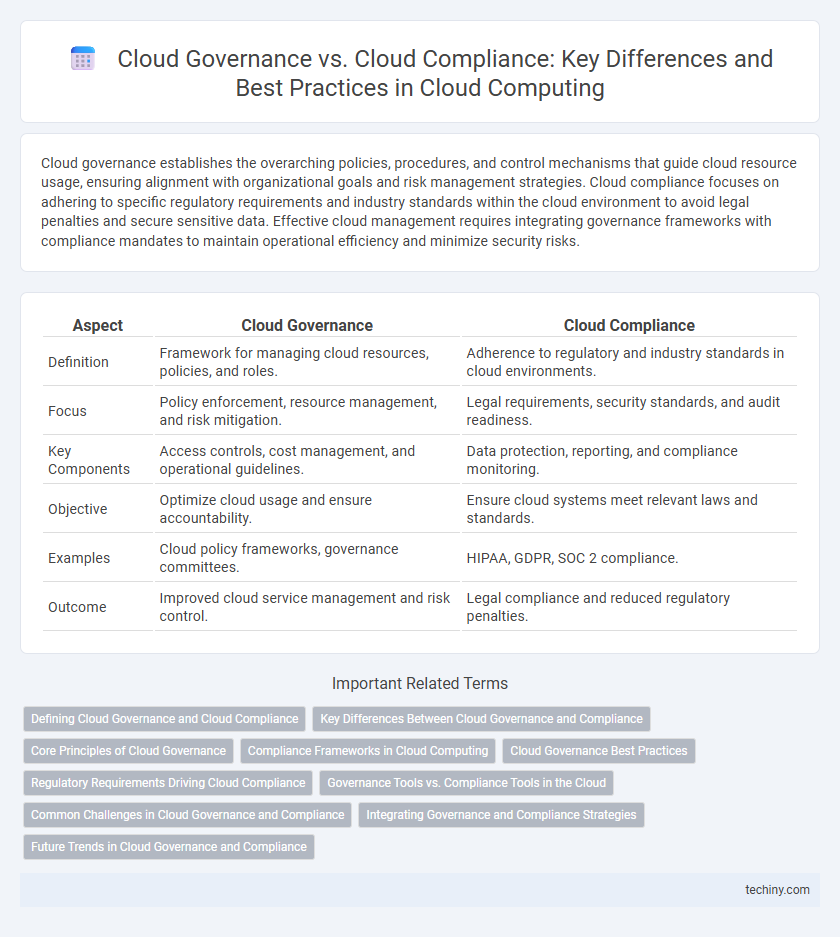Cloud governance establishes the overarching policies, procedures, and control mechanisms that guide cloud resource usage, ensuring alignment with organizational goals and risk management strategies. Cloud compliance focuses on adhering to specific regulatory requirements and industry standards within the cloud environment to avoid legal penalties and secure sensitive data. Effective cloud management requires integrating governance frameworks with compliance mandates to maintain operational efficiency and minimize security risks.
Table of Comparison
| Aspect | Cloud Governance | Cloud Compliance |
|---|---|---|
| Definition | Framework for managing cloud resources, policies, and roles. | Adherence to regulatory and industry standards in cloud environments. |
| Focus | Policy enforcement, resource management, and risk mitigation. | Legal requirements, security standards, and audit readiness. |
| Key Components | Access controls, cost management, and operational guidelines. | Data protection, reporting, and compliance monitoring. |
| Objective | Optimize cloud usage and ensure accountability. | Ensure cloud systems meet relevant laws and standards. |
| Examples | Cloud policy frameworks, governance committees. | HIPAA, GDPR, SOC 2 compliance. |
| Outcome | Improved cloud service management and risk control. | Legal compliance and reduced regulatory penalties. |
Defining Cloud Governance and Cloud Compliance
Cloud governance establishes the framework of policies, roles, and controls to manage cloud resources effectively and ensure alignment with organizational goals. Cloud compliance involves adhering to regulatory standards and internal policies to safeguard data privacy, security, and risk management within cloud environments. Together, governance sets the strategic direction while compliance enforces mandatory requirements for cloud operations.
Key Differences Between Cloud Governance and Compliance
Cloud governance establishes the overarching framework of policies, roles, and responsibilities to manage cloud resources effectively, ensuring strategic alignment and performance optimization. Cloud compliance specifically focuses on adhering to regulatory standards, legal requirements, and industry-specific rules to avoid penalties and maintain security protocols. The key difference lies in governance driving decision-making processes and cloud management, while compliance ensures that all cloud operations meet external audit and regulatory mandates.
Core Principles of Cloud Governance
Cloud Governance centers on establishing policies, roles, and responsibilities to ensure efficient, secure, and compliant cloud resource management, emphasizing accountability, transparency, and risk management. Core principles include defining clear security policies, implementing access controls, continuous monitoring, and ensuring cost management aligns with organizational objectives. Unlike Cloud Compliance, which focuses on adhering to external regulations and standards, Cloud Governance provides the strategic framework enabling sustainable and controlled cloud operations.
Compliance Frameworks in Cloud Computing
Cloud compliance in cloud computing involves adhering to specific compliance frameworks such as GDPR, HIPAA, and ISO/IEC 27001, which define the legal and regulatory requirements for data protection and privacy. Cloud governance establishes policies and controls to manage cloud resources, ensuring alignment with these compliance frameworks while optimizing security and operational efficiency. Effective cloud compliance frameworks enable organizations to mitigate risks, demonstrate accountability, and maintain regulatory certifications in cloud environments.
Cloud Governance Best Practices
Cloud governance establishes policies, roles, and controls to manage cloud resources effectively, while cloud compliance ensures adherence to regulatory standards and industry requirements. Best practices for cloud governance include defining clear ownership and accountability, implementing strict access controls using role-based access management, and continuously monitoring resource usage and security posture through automated tools. Consistent policy enforcement and regular audits help maintain alignment between organizational objectives and cloud operations.
Regulatory Requirements Driving Cloud Compliance
Regulatory requirements such as GDPR, HIPAA, and PCI-DSS drive cloud compliance by enforcing data protection, privacy, and security standards that organizations must meet when utilizing cloud services. Cloud governance provides the frameworks and policies to manage cloud resources effectively, but cloud compliance ensures adherence to these legal and regulatory mandates. Compliance-driven audits and continuous monitoring are essential to mitigate risks and avoid penalties associated with non-compliance in cloud environments.
Governance Tools vs. Compliance Tools in the Cloud
Cloud governance tools provide automated policy enforcement, resource management, and cost control to ensure organizational standards are maintained across cloud environments. Compliance tools focus on continuous monitoring, audit readiness, and regulatory adherence by mapping cloud configurations against frameworks like GDPR, HIPAA, and PCI DSS. Effective cloud management requires integrating governance tools for strategic oversight with compliance tools for real-time risk detection and reporting.
Common Challenges in Cloud Governance and Compliance
Common challenges in cloud governance and compliance include managing data security across multiple cloud environments, ensuring regulatory adherence amid rapidly changing policies, and maintaining visibility over cloud resource usage. Organizations often struggle with establishing clear accountability and automation to enforce governance policies effectively. Balancing flexibility and control while mitigating risks remains a critical obstacle in achieving robust cloud governance and compliance frameworks.
Integrating Governance and Compliance Strategies
Integrating cloud governance and compliance strategies ensures a unified framework for managing cloud resources while adhering to regulatory requirements such as GDPR and HIPAA. Effective cloud governance establishes policies and controls for resource allocation, security, and risk management, which align directly with compliance mandates to avoid legal penalties and data breaches. Leveraging automation tools like AWS Config and Azure Policy enables continuous monitoring and enforcement of both governance policies and compliance standards in real-time.
Future Trends in Cloud Governance and Compliance
Future trends in cloud governance emphasize automated policy enforcement using AI and machine learning to enhance risk mitigation and streamline operations. Compliance frameworks are evolving to integrate real-time monitoring and adaptive controls that respond to dynamic regulatory environments, ensuring continuous alignment with global standards such as GDPR, HIPAA, and CCPA. Organizations are increasingly adopting hybrid and multi-cloud governance models to maintain flexibility while achieving comprehensive visibility and control across diverse cloud infrastructures.
Cloud Governance vs Cloud Compliance Infographic

 techiny.com
techiny.com